The Splendour of Glitter: Silver Leaf in barniz de Pasto Objects
Abstract
1. Introduction
2. Materials and Methods
- The thickness and relief of the barniz decorations;
- The opacity or shine of the surface;
- The appearance of vibrant colours;
- The presence of metallic glittery elements.
3. Results
3.1. The Barniz de Pasto Technique before the Introduction of Metals
3.2. The Start of the Colonial Period
3.3. Introduction of Silver Leaf
3.4. Iridescent Effects
3.5. The Appearance of Other Metals
4. Conclusions
Supplementary Materials
Author Contributions
Funding
Data Availability Statement
Acknowledgments
Conflicts of Interest
References
- Newman, R.; Kaplan, E.; Álvarez-White, M.C. The History of Elaeagia Resin (Mopa-Mopa), So Far. Heritage 2023, 6, 4320–4344. [Google Scholar] [CrossRef]
- Melchar, D.; Burgio, L.; Fernández, V.; Keneghan, B.; Newman, R. A collaborative, multidisciplinary and multi-analytical approach to the characterisation of barniz de Pasto objects from the V&A collections. In Transcending Boundaries: Integrated ICOM-CC 19thTriennial Conference Preprints; Bridgland, J., Ed.; International Council of Museums: Paris, France, 2021; pp. 1–8. [Google Scholar]
- Pozzi, F.; Basso, E.; Katz, M. In search of Humboldt’s colors: Materials and techniques of a 17th-century lacquered gourd from Colombia. Herit. Sci. 2020, 8, 2–16. [Google Scholar] [CrossRef]
- Sánchez, L.A. Análisis de los materiales de una arqueta decorada con barniz de Pasto, perteneciente a la colección del Museo de América de Madrid. An. Mus. Am. 2020, 28, 170–179. [Google Scholar]
- Burgio, L.; Melchar, D.; Strekopytov, S.; Peggie, D.; Melchiorre, M.; Keneghan, B.; Najorka, J.; Goral, T.; Garbout, A.; Clark, B. Identification, characterisation and mapping of calomel as ‘mercury white’, a previously undocumented pigment from South America, and its use on a barniz de Pasto cabinet at the Victoria and Albert Museum. Microchem. J. 2018, 143, 220–227. [Google Scholar] [CrossRef]
- Álvarez-White, M.C. El Barniz de Pasto. Secretos y Revelaciones; Ediciones Universidad de los Andes: Bogotá, Colombia, 2023; p. 190. ISBN 978-958-798-318-0. [Google Scholar]
- Simón, P. Noticias Historiales de las Conquistas de Tierra Firme en las Indias Occidentales; Biblioteca del Banco de la República; Imprenta Medardo Rivas: Bogotá, Colombia, 1891. [Google Scholar]
- Fernández de Piedrahita, L. Historia General de las Conquistas del Nuevo Reyno de Granada; Imprenta Medardo Rivas: Bogotá, Colombia, 1881; Volumes 1–2. [Google Scholar]
- Juan, J.; de Ulloa, A. Relacion Historica del Viage a la America Meridional Hecho de Orden de S. Mag. Para Medir algunos Grados de Meridiano Terrestre, y Venir por Ellos en Conocimiento de la Verdadera Figura y Magnitud de la Tierra, Con Otras Observaciones Astronómicas y Phisicas; Antonio Marin: Madrid, Spain, 1748. [Google Scholar]
- Robinson, D. Diario de don Miguel de Santisteban. Mil Leguas por América: De Lima a Caracas, 1740–1741; Banco de la República: Bogotá, Colombia, 1992; ISBN 978-958-902-880-3. [Google Scholar]
- Magnin, J. Descripción de la Provincia y Misiones de Mainas en el Reino de Quito [1740–1745]; Biblioteca Ecuatoriana Aurelio Espinosa Pólit: Quito, Ecuador, 1998; ISBN 997-840-500-3. [Google Scholar]
- De Santa Gertrudis, J. Maravillas de la Naturaleza; Linkgua Ediciones: Madrid, Spain, 2010; Volumes 1–4, ISBN 978-849-816-561-6. [Google Scholar]
- De Velasco, J. Historia del Reino de Quito. La Historia Natural [1727–1792]; Empresa Editora El Comercio: Quito, Ecuador, 1946; Volume 1. [Google Scholar]
- Humboldt, A. Alexander von Humboldt en Colombia: Extractos de Sus Diarios; Academia Colombiana de Ciencias Exactas, Físicas y Naturales: Bogotá, Colombia, 1982; p. 127. [Google Scholar]
- Mutis, J.C.; Hernández de Alba, G. Diario de Observaciones de José Celestino Mutis 1760–1790; Editorial Minerva: Bogotá, Colombia, 1958. [Google Scholar]
- Hamilton, J.P. Viajes por el Interior de las Provincias de Colombia (1824); Publicaciones del Banco de la República: Bogotá, Colombia, 1955. [Google Scholar]
- Boussingault, J.B. Memorias; Banco de la República; Departamento Editorial: Bogotá, Colombia, 1985; Volume 5. [Google Scholar]
- André, É.F. América equinoccial (Colombia-Ecuador). In América Pintoresca: Descripción de Viajes al Nuevo Continente por los Mas Modernos Exploradores; Wiener, E.C., Wiener, C., Hildibrand, H., Kohl, A., Barbant, C., Vignal, P., Riou, E., Eds.; Edición Facsimilar de Carvajal S.A.: Bogotá, Colombia, 1981; Volume 3, pp. 755–767. [Google Scholar]
- Holton, I.F. La Nueva Granada: Veinte Meses en los Andes; Ediciones Banco de la República: Bogotá, Colombia, 1981. [Google Scholar]
- Duque, G.L.; Cubillos, J.C. Arqueología de San Agustín: Alto de Lavapatas; Fundación de Investigaciones Arqueológicas Nacionales; Banco de la República: Bogotá, Colombia, 1988. [Google Scholar]
- Uribe, M.V. Pastos y protopastos: La red regional de intercambio de productos y materias primas de los siglos x a xvi d. C. Maguaré 1986, 3, 33–46. [Google Scholar]
- Humphrey, N.; Burgio, L.; Melchar, D. One small corner of the Viceroyalty in South Kesington: barniz de Pasto at the Victoria and Albert Museum, London. An. Mus. Am. 2020, 28, 150. [Google Scholar]
- Sánchez, J.M.; Quiñones, M.D. Materiales pictóricos enviados a América en el siglo XVI. An. Inst. Investig. Estéticas 2009, 31, 45–67. [Google Scholar] [CrossRef][Green Version]
- Newman, R.; Derrick, M. Painted Qero Cups from the Incas and Colonial Periods in Peru: An Analytical Study of Pigments and Media. In Materials Issues in Art and Archaeology VI; Vandiver, P., Goodway, M., Druzik, J.R., Mass, J.L., Eds.; Materials Research Society: Warrendale, PA, USA, 2002; pp. 291–302. [Google Scholar]
- Newman, R.; Derrick, M. Analytical Report Lab; Project 2016-58 No. BP-15; Scientific Research Lab, Museum of Fine Artes: Boston, MA, USA, 2016. [Google Scholar]
- Álvarez-White, M.C. El barniz de Pasto: Reflejo de la naturaleza. In Barroco. Naturaleza y Paisaje. IX Encuentro Internacional Sobre Barroco; Fundación Visión Cultural: La Paz, Bolivia, 2019; pp. 339–346. [Google Scholar]
- Kawamura, Y. (Ed.) Laca japonesa urushi de estilo namban en España. Vías de su llegada y sus destinos. In Lacas Namban: Huellas de Japón en España. IV Centenario de la Embajada de Keicho; Fundación Japón y Ministerio de Educación, Cultura y Deporte: Madrid, Spain, 2013; pp. 249–296. [Google Scholar]
- Romero, R.; Adelina, I.; Bondía, C. Consideraciones preliminares sobre la técnica y restauración de objetos de barniz de Pasto o mopa-mopa. An. Mus. Am. 2020, 28, 157–169. [Google Scholar]
- Barba, A. Arte de los Metales: En Que se Enseña el Verdadero Beneficio de los de Oro y Plata Por Azogue: El Modo de Fundirlos Todos, y Como se Han de Refinar y Apartar Unos de Otros. Nuevamente Ahora Añadido Con el Tratado de las Antiguas Minas de España, (1817); Legare Street Press: USA, 2022; ISBN 9781019231777. [Google Scholar]
- Crippa, M.; Legnaioli, S.; Kimbriel, C.; Ricciardi, P. New evidence for the intentional use of calomel as a white Pigment. J. Raman Spectrosc. 2021, 52, 15. [Google Scholar] [CrossRef]
- Cicala, M.S.J. Descripción Histórico-TOPOGRÁFICA de la Provincia de Quito de la Compañía de Jesús, Parte Primera Viterbo, 1771; tomo 2; Biblioteca Ecuatoriana Aurelio Espinosa Pólit e Instituto Geográfico Militar: Quito, Ecuador, 1994; ISBN 978971106. [Google Scholar]
- de Friedemann, N. El barniz de Pasto. Arte y rito milenario Rev. Lámpara 1985, 23, 15–24. [Google Scholar]
- Bruquetas, R.G. Técnicas y Materiales de la Pintura Española en los Siglos de Oro; Fundación Telefónica de Madrid: Madrid, España, 1992; p. 560. ISBN 9788493003036. [Google Scholar]
- Santiesteban, M. Mil Leguas por América, de Lima a Caracas, 1740–1741. Diario de don Miguel de Santisteban; Robinson, D.J., Ed.; Banco de la República: Bogotá, Colombia, 1992. [Google Scholar]



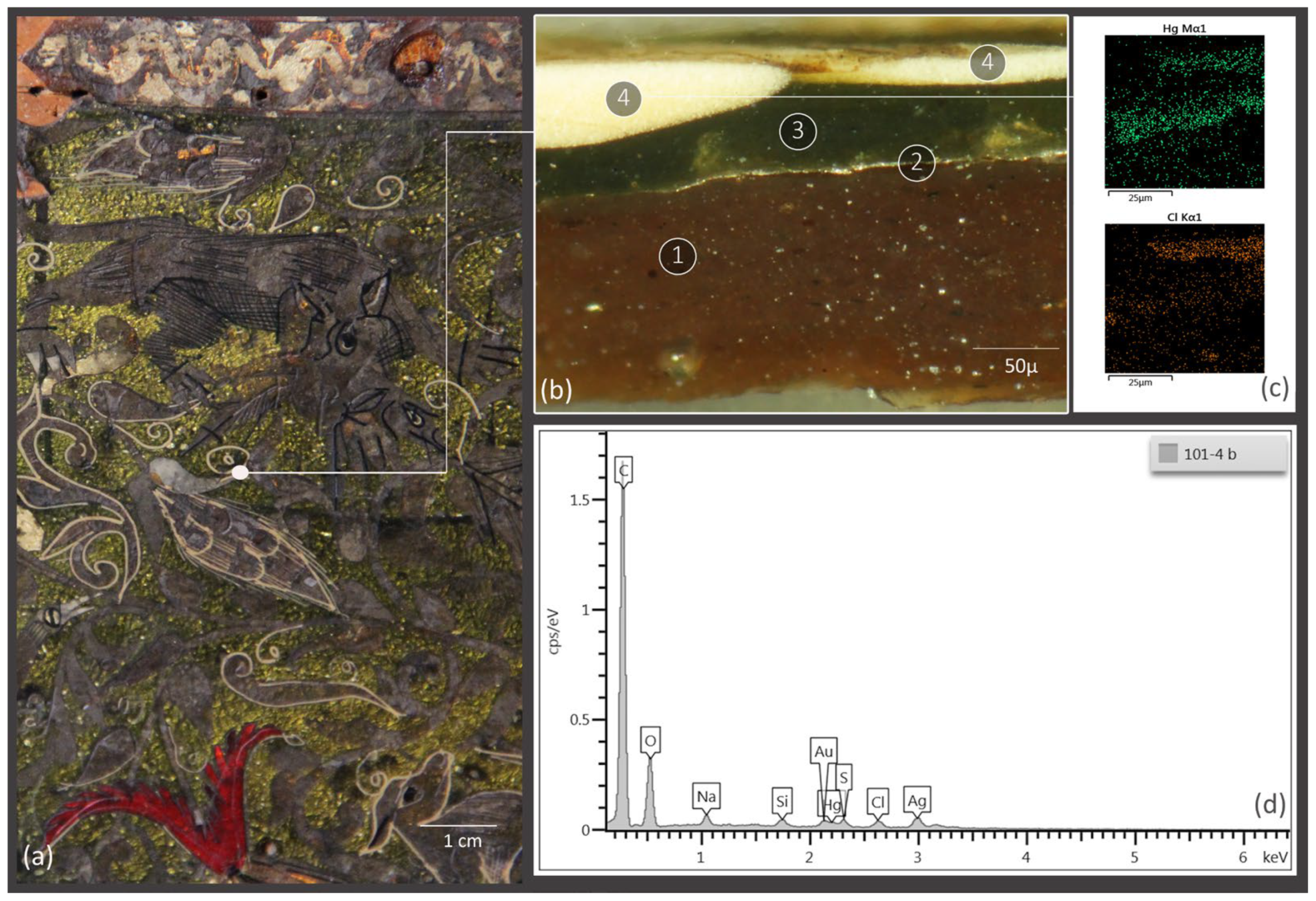
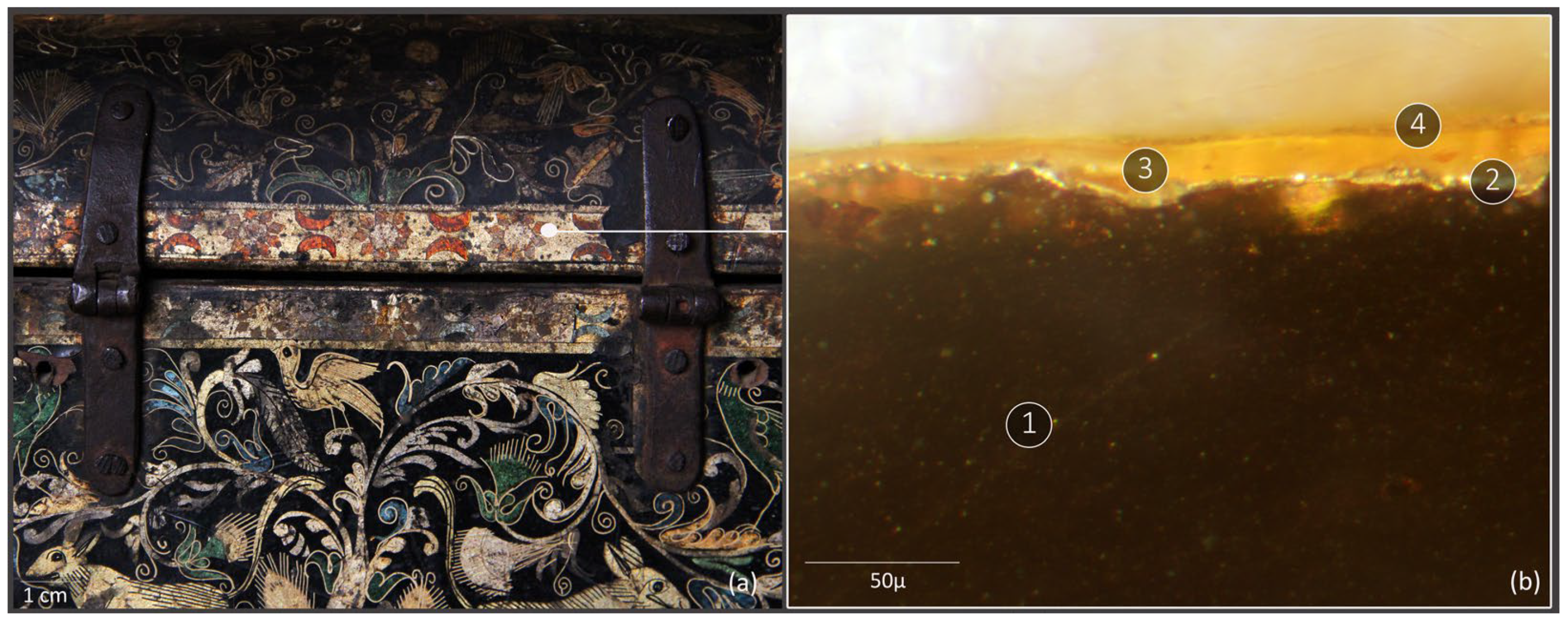
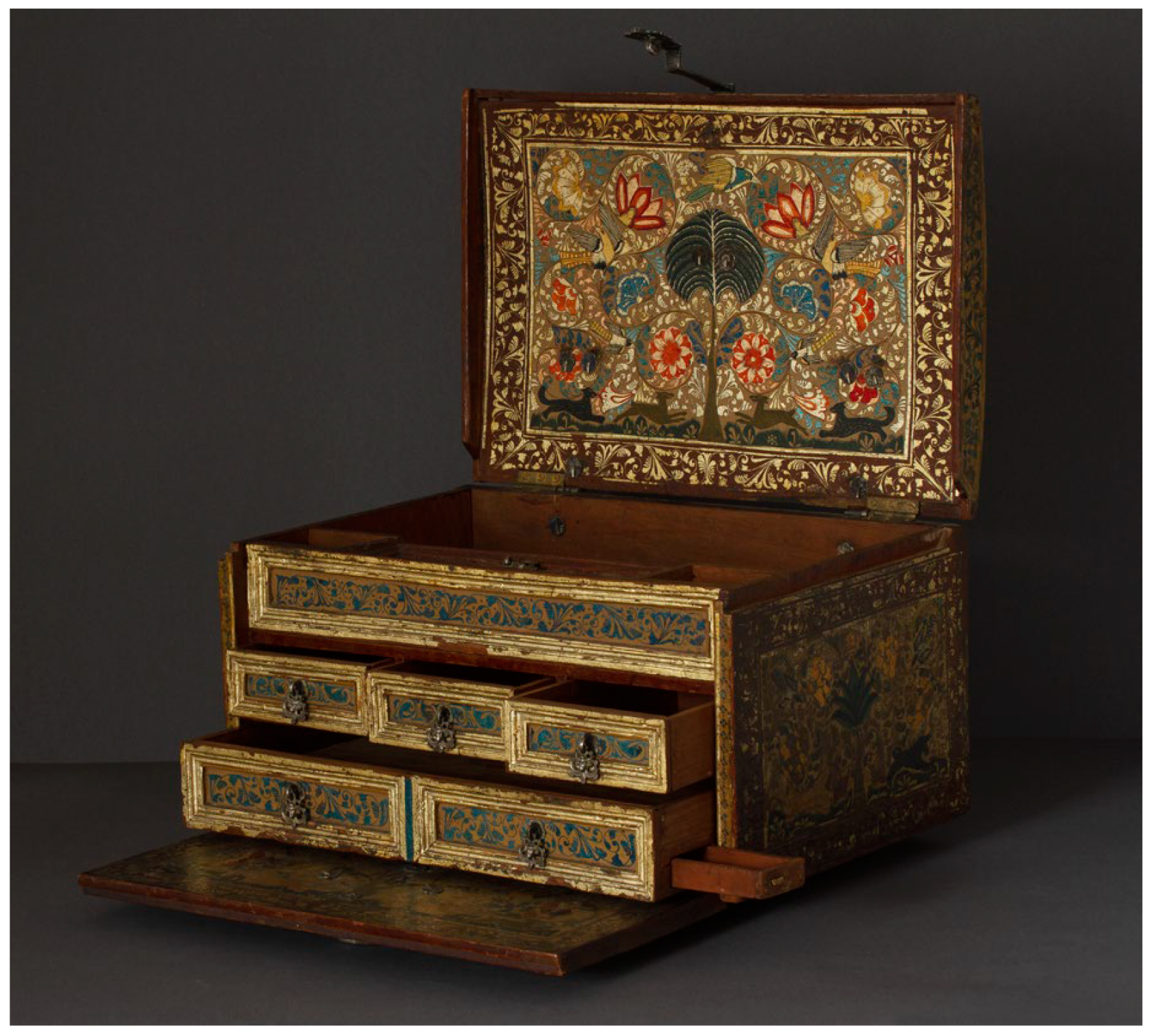
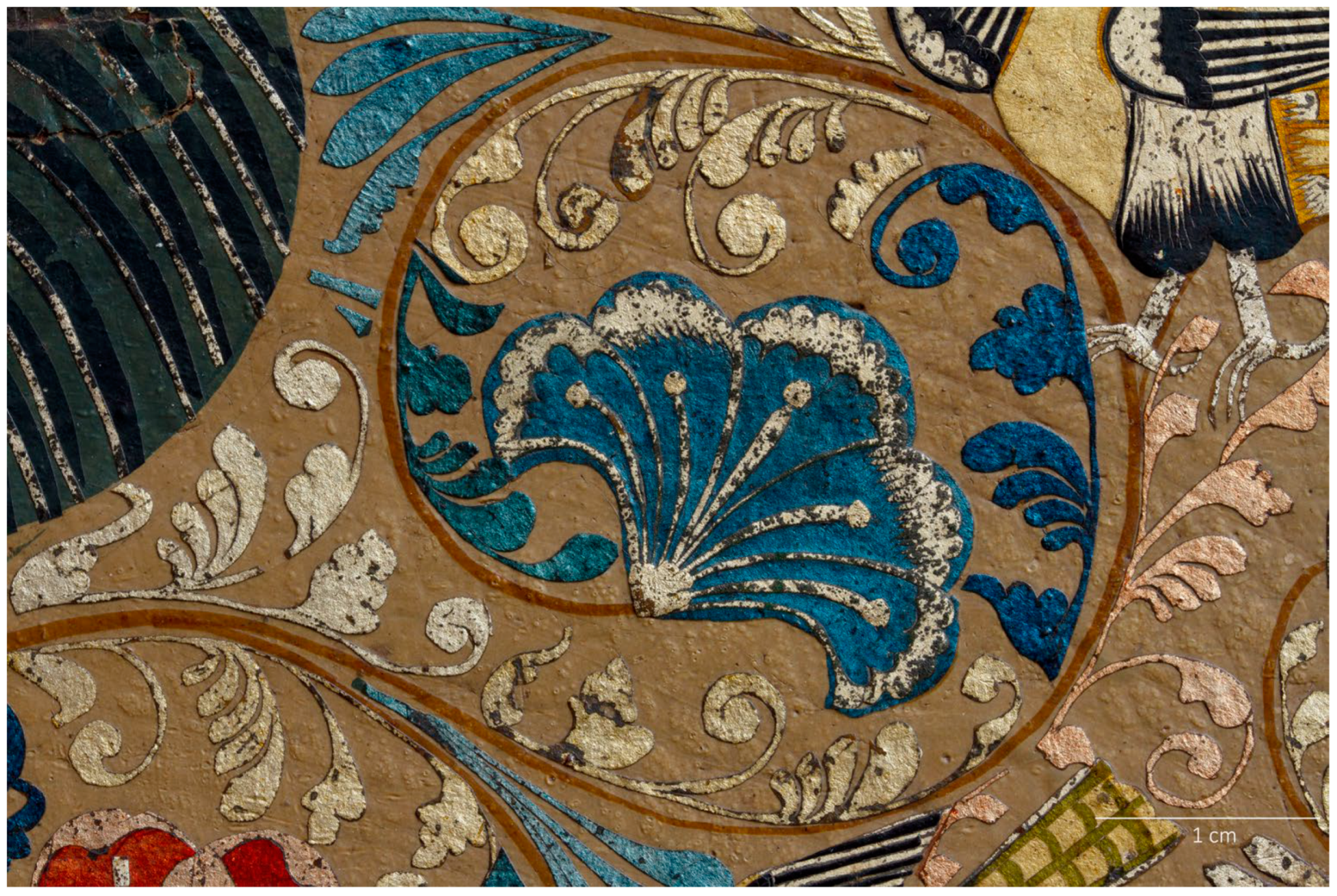
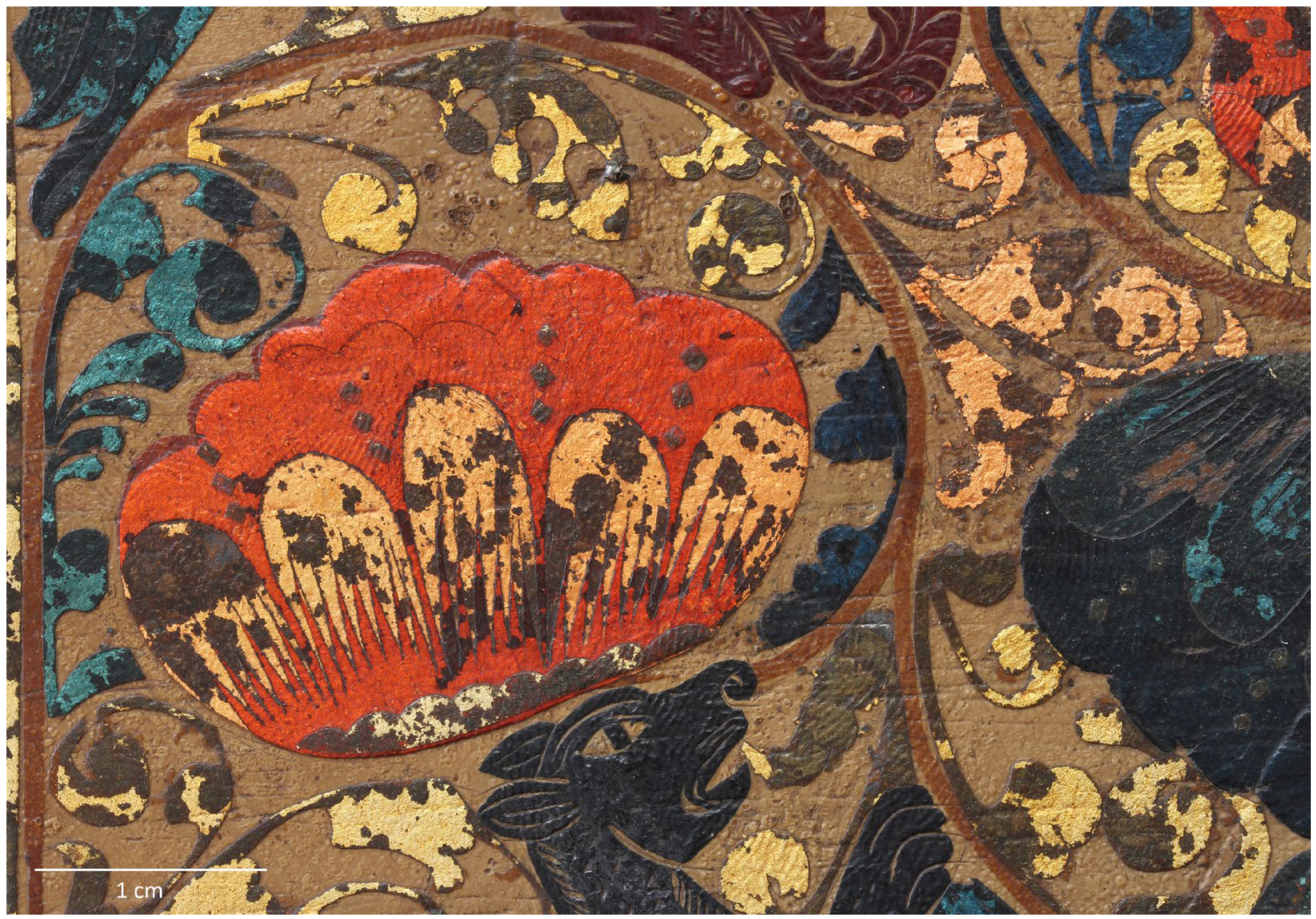
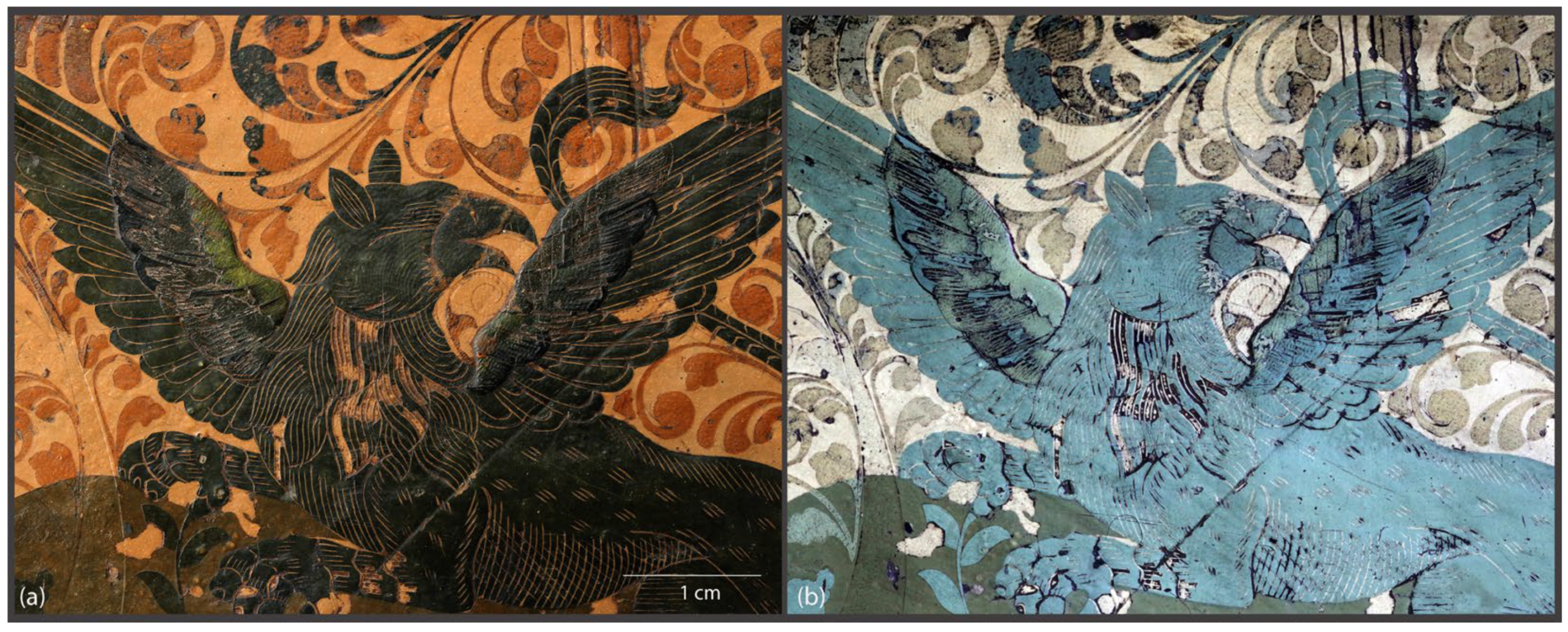
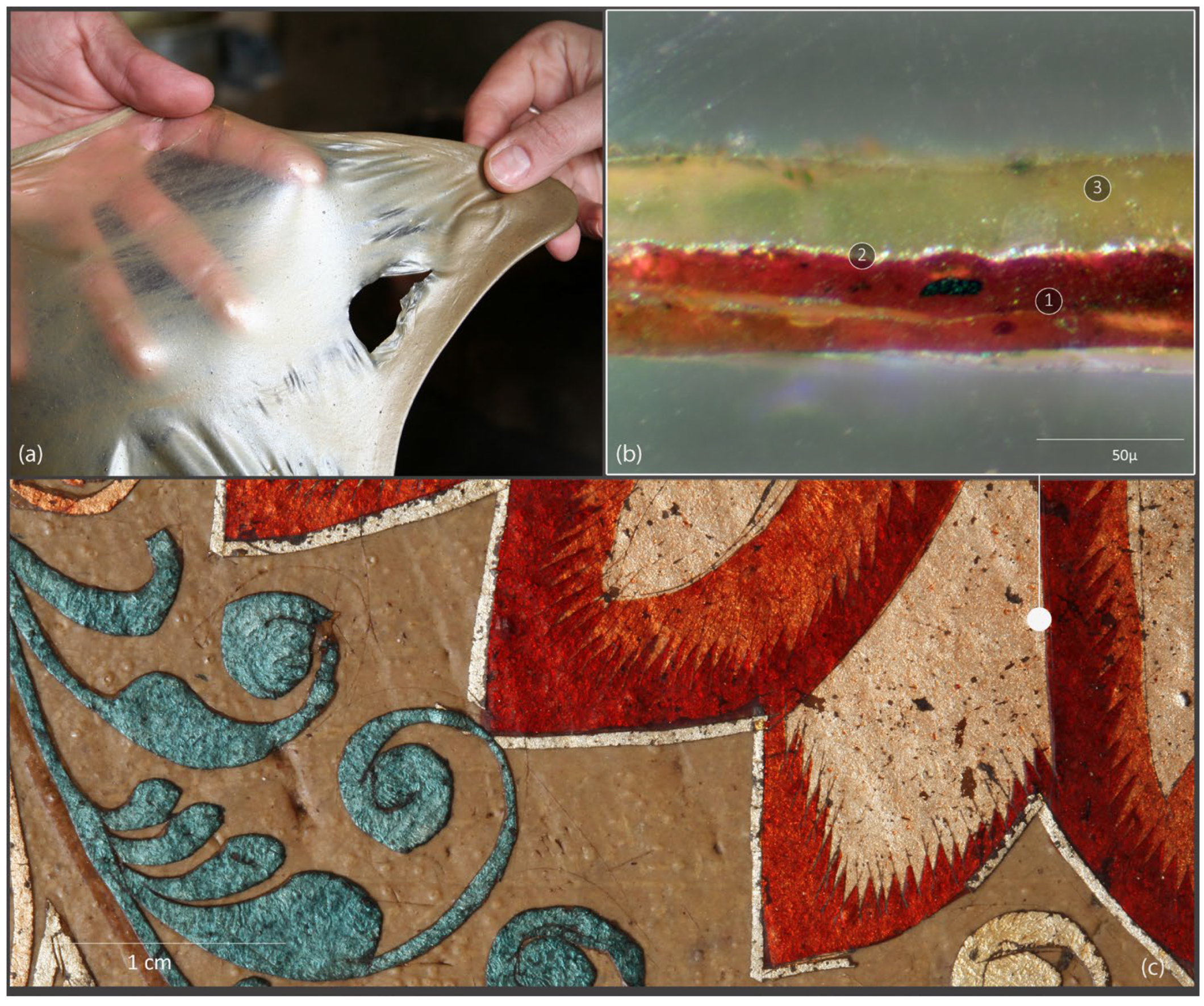

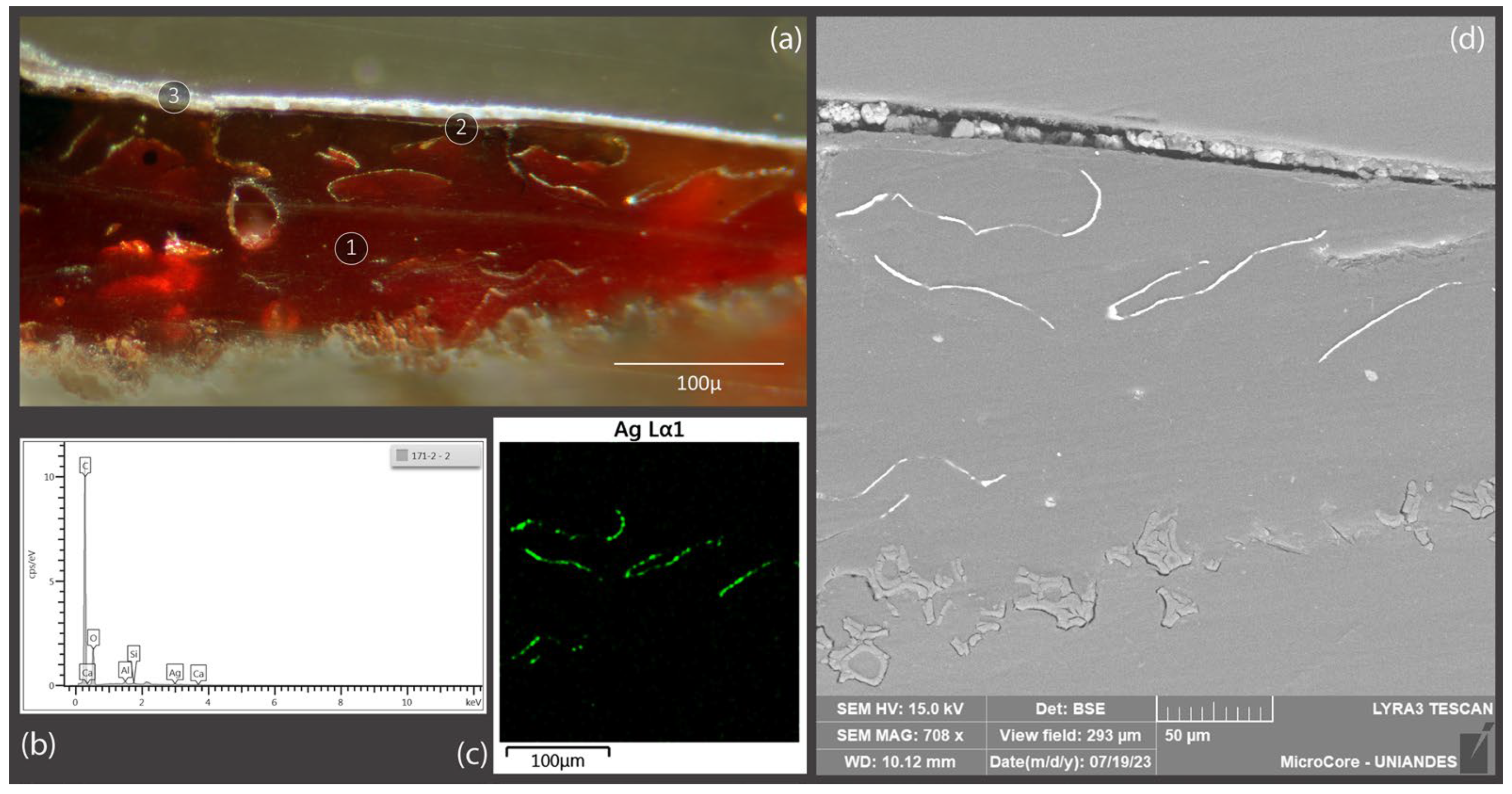
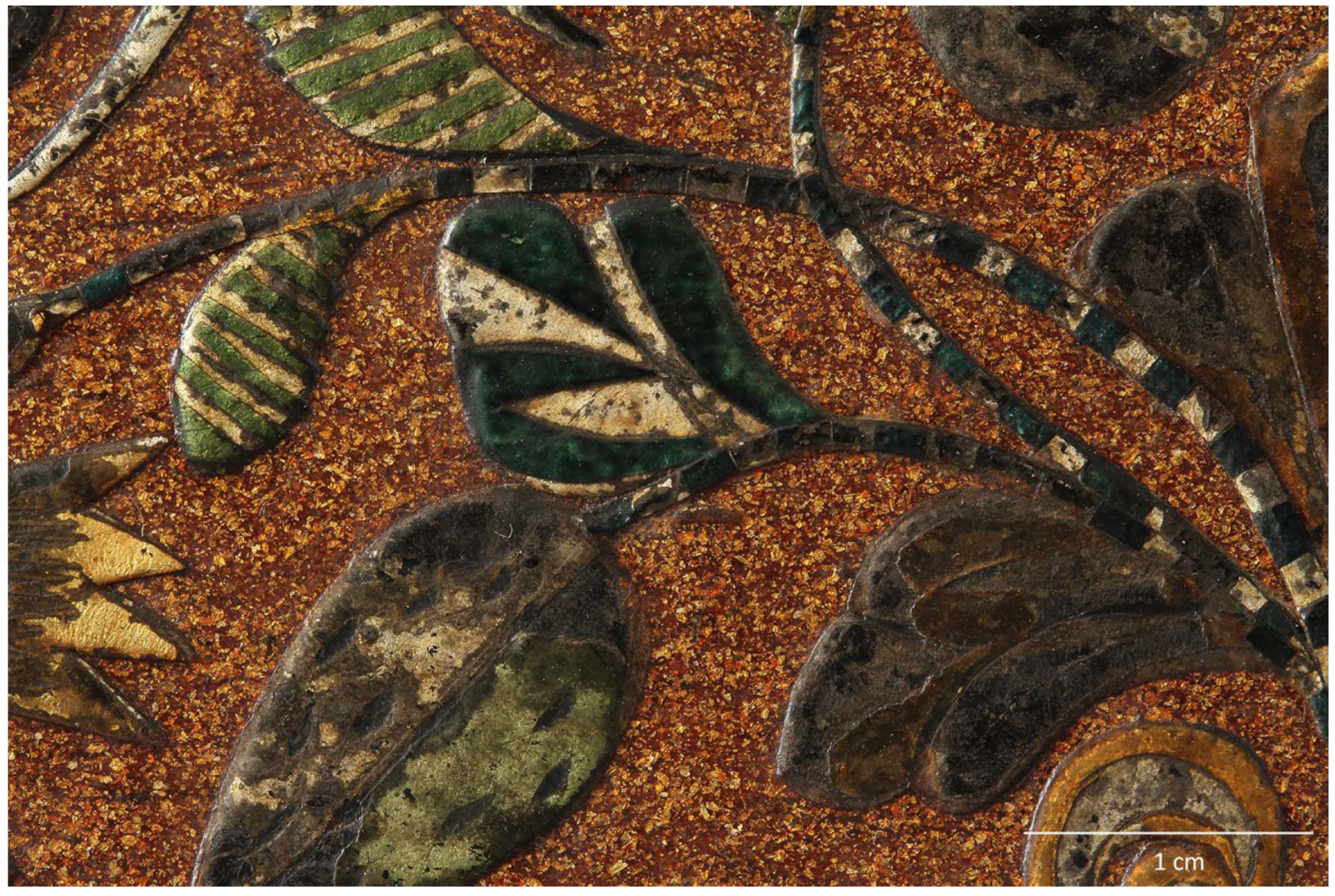
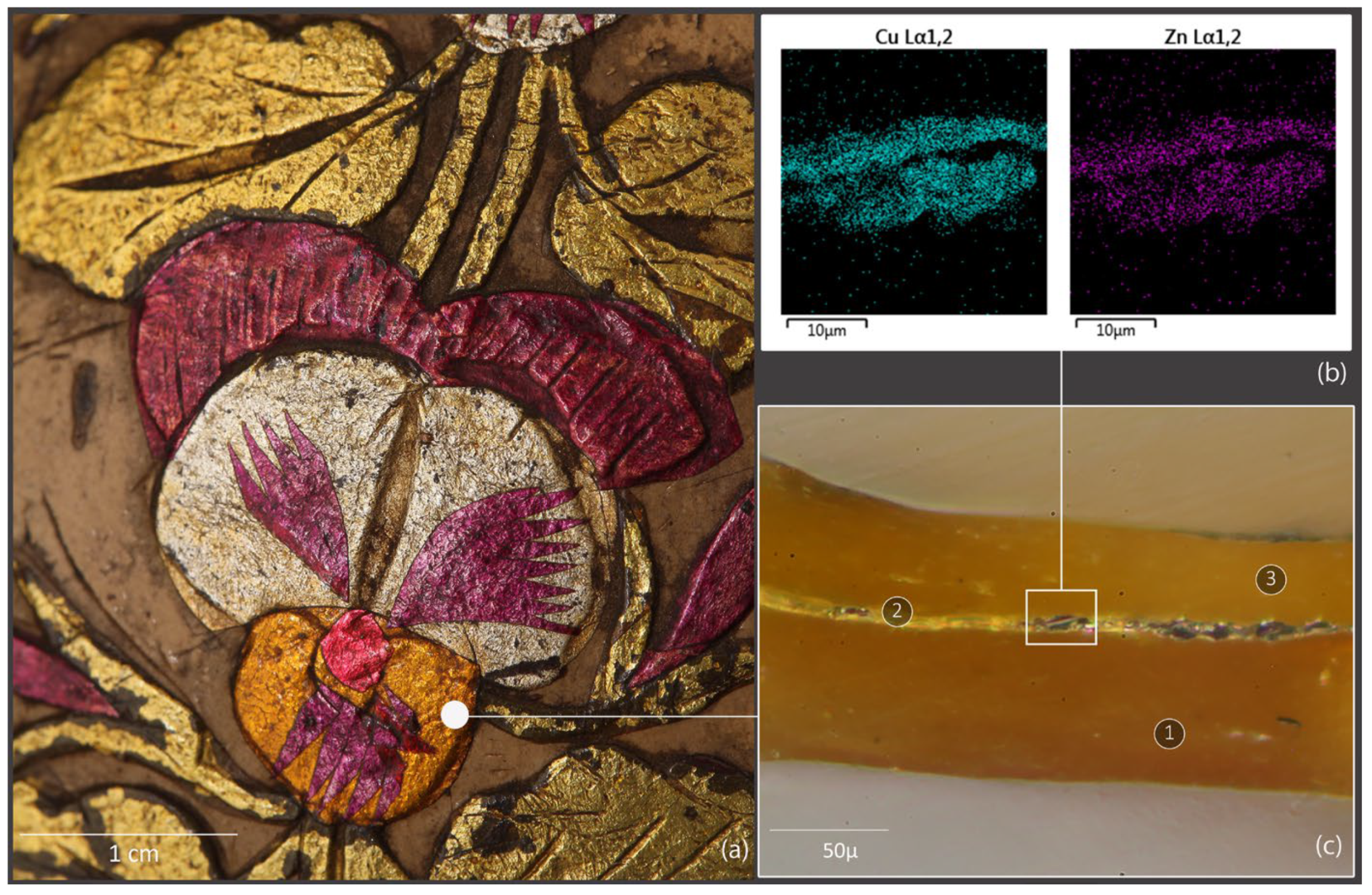
Disclaimer/Publisher’s Note: The statements, opinions and data contained in all publications are solely those of the individual author(s) and contributor(s) and not of MDPI and/or the editor(s). MDPI and/or the editor(s) disclaim responsibility for any injury to people or property resulting from any ideas, methods, instructions or products referred to in the content. |
© 2023 by the authors. Licensee MDPI, Basel, Switzerland. This article is an open access article distributed under the terms and conditions of the Creative Commons Attribution (CC BY) license (https://creativecommons.org/licenses/by/4.0/).
Share and Cite
Álvarez-White, M.C.; Cohen, D.; Fernández, M.O. The Splendour of Glitter: Silver Leaf in barniz de Pasto Objects. Heritage 2023, 6, 6581-6595. https://doi.org/10.3390/heritage6100344
Álvarez-White MC, Cohen D, Fernández MO. The Splendour of Glitter: Silver Leaf in barniz de Pasto Objects. Heritage. 2023; 6(10):6581-6595. https://doi.org/10.3390/heritage6100344
Chicago/Turabian StyleÁlvarez-White, María Cecilia, David Cohen, and Mario Omar Fernández. 2023. "The Splendour of Glitter: Silver Leaf in barniz de Pasto Objects" Heritage 6, no. 10: 6581-6595. https://doi.org/10.3390/heritage6100344
APA StyleÁlvarez-White, M. C., Cohen, D., & Fernández, M. O. (2023). The Splendour of Glitter: Silver Leaf in barniz de Pasto Objects. Heritage, 6(10), 6581-6595. https://doi.org/10.3390/heritage6100344






